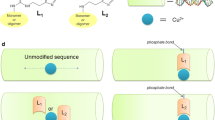Abstract
Simple copper salts are known to denature poly d(GC). On the other hand, copper complexes of substituted 1,4,7,10,13-pentaazacyclohexadecane-14,16-dione are able to convert the right-handed B form of the same DNA sequence to the corresponding left-handed Z form. A research program was started in order to understand why Cu(II) as an aquated ion melts DNA and induces the conformational change to Z-DNA in the form of an azamacrocyclic complex. In this paper, we present a continuous wave and pulse electron paramagnetic resonance study of the mononucleotide model system Cu(II)–guanosine 5′-monophosphate . Pulse EPR methods like electron–nuclear double resonance and hyperfine sublevel correlation spectroscopy provide unique information about the electronic and geometric structure of this model system through an elaborate mapping of the hyperfine and nuclear quadrupole interactions between the unpaired electron of the Cu(II) ion and the magnetic nuclei of the nucleotide ligand. It was found that the Cu(II) ion is directly bound to N7 of guanosine 5′-monophosphate and indirectly bound via a water of hydration to a phosphate group. This set of experiments opens the way to more detailed structural characterization of specifically bound metal ions in a variety of nucleic acids of biological interest, in particular to understand the role of the metal–(poly)nucleotide interaction.







Similar content being viewed by others
Abbreviations
- CW:
-
Continuous wave
- DMSO:
-
Dimethyl sulfoxide
- ENDOR:
-
Electron-nuclear double resonance
- EPR:
-
Electron paramagnetic resonance
- 5′-GMP:
-
Guanosine 5′-monophosphate
- HYSCORE:
-
Hyperfine sublevel correlation
- Triflate:
-
Trifluoromethanesulfonate
References
Spingler B (2005) Inorg Chem 44:831–833
Spingler B, Da Pieve C (2005) Dalton Trans 1637–1643
Geierstanger BH, Kagawa TF, Chen S-L, Quigley GJ, Ho PS (1991) J Biol Chem 266:20185–20191
Hiai S, Suzuki K, Moriguchi E (1965) J Mol Biol 11:672–691
Sundaralingam M, Carrabine JA (1971) J Mol Biol 61:287–309
Farrar JA, Neese F, Lappalainen P, Kroneck PMH, Saraste M, Zumft WG, Thomson AJ (1996) J Am Chem Soc 118:11501–11514
Andersson KK, Schmidt PP, Katterle B, Strand KR, Palmer AE, Lee SK, Solomon EI, Graslund A, Barra AL (2003) J Biol Inorg Chem 8:235–247
Calle C, Sreekanth A, Fedin MV, Forrer J, Garcia-Rubio I, Gromov IA, Hinderberger D, Kasumaj B, Leger P, Mancosu B, Mitrikas G, Santangelo MG, Stoll S, Schweiger A, Tschaggelar R, Harmer J (2006) Helv Chim Acta 89:2495–2521
delaFuente M, Cozar O, David L, Navarro R, Hernanz A, Bratu I (1997) Spectrochim Acta Part A 53:637–641
Weckhuysen BM, Leeman H, Schoonheydt RA (1999) Phys Chem Chem Phys 1:2875–2880
Kaczmarek P, Jezowska-Bojczuk M (2005) Inorg Chim Acta 358:2073–2076
Hoogstraten CG, Grant CV, Horton TE, DeRose VJ, Britt RD (2002) J Am Chem Soc 124:834–842
Schweiger A, Jeschke G (2001) Principles of pulse electron paramagnetic resonance. Oxford University Press, Oxford
Deligiannakis Y, Louloudi M, Hadjiliadis N (2000) Coord Chem Rev 204:1–112
Davies ER (1974) Phys Lett A 47:1–2
Mims WB (1965) Proc R Soc Lond 283:452–457
Stoll S, Schweiger A (2006) J Magn Reson 178:42–55
Madi ZL, Van Doorslaer S, Schweiger A (2002) J Magn Reson 154:181–191
Dikanov SA, Tsvetkov YD, Bowman MK, Astashkin AV (1982) Chem Phys Lett 90:149–153
Sigel H, Massoud SS, Corfu NA (1994) J Am Chem Soc 116:2958–2971
Sigel H, Song B (1996) Met Ions Biol Syst 32:135–205
McGarvey BR (1966) In: Carlin RL (ed) Transition metal chemistry. Dekker, New York, pp 89–201
Peisach J, Blumberg WE (1974) Arch Biochem Biophys 165:691–708
Schosseler PM, Wehrli B, Schweiger A (1997) Inorg Chem 36:4490–4499
Atherton NM, Horsewill AJ (1979) Mol Phys 37:1349–1361
Manikandan P, Epel B, Goldfarb D (2001) Inorg Chem 40:781–787
Dikanov SA, Xun LY, Karpiel AB, Tyryshkin AM, Bowman MK (1996) J Am Chem Soc 118:8408–8416
Garcia MLS, Smith JAS (1983) J Chem Soc Perkin Trans II 1401–1408
Stoll S, Calle C, Mitrikas G, Schweiger A (2005) J Magn Reson 177:93–101
Zanker PP, Jeschke G, Goldfarb D (2005) J Chem Phys 122:024515
Sletten E, Lie B (1976) Acta Crystallogr Sect B 32:3301–3304
Allen FH, Kennard O (1993) Chem Des Automat News 8:31–37
Sheldrick WS (1981) Acta Crystallogr Sect B 37:1820–1824
Acknowledgements
We thank R.K.O. Sigel and C. Finazzo for stimulating discussions. We thank ETH and the Swiss National Science Foundation for financial support.
Author information
Authors and Affiliations
Corresponding authors
Additional information
Arthur Schweiger died on 4 January 2006.
Rights and permissions
About this article
Cite this article
Santangelo, M.G., Medina-Molner, A., Schweiger, A. et al. Structural analysis of Cu(II) ligation to the 5′-GMP nucleotide by pulse EPR spectroscopy. J Biol Inorg Chem 12, 767–775 (2007). https://doi.org/10.1007/s00775-007-0230-1
Received:
Accepted:
Published:
Issue Date:
DOI: https://doi.org/10.1007/s00775-007-0230-1




